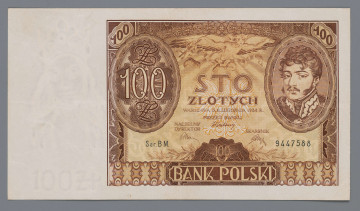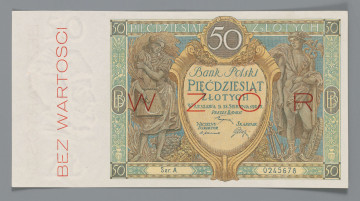
100 zlotys
1934
National Museum in Lublin
Part of the collection: Paper money during the Second Polish Republic
After the initial euphoria caused by Poland's regaining independence, it soon became apparent that the authorities of the reborn state faced extremely difficult tasks. In domestic politics, the most serious problem was the integration of a state consisting of three separate organisms. In the economic sphere, a major problem was the monetary system inherited from the Partitioners. Apart from marks, crowns and roubles, there were Polish marks in circulation issued from 1916 on the territory of the General Government of Warsaw, which was subordinate to Germany, as well as the so-called ‘ostruble’ in the eastern territories occupied by Germany and Austria-Hungary as the result of the 1915 offensive, and even Ukrainian hryvnias. In this situation, the need of the hour was to unify the circulating currency. As early as on 5 February 1919, the Treasury Ministry announced the introduction of a new Polish currency, which was to be called ‘lech’. The relevant decree was even signed by Józef Piłsudski, but in the end a more historically motivated name – to which the numismatist Marian Gumowski made a significant contribution – was chosen, namely zloty. In the same year, a decision was made to print zloty banknotes with face values from 1 to 5,000 zlotys. All of them bore the date of 28 February 1919 on the obverse. The 5-zloty banknotes were issued in an edition of 16,784,622 pieces, which was equivalent to 83,923,110 zlotys. The printing, like the one-, two-, ten-, twenty- and fifty-zloty banknotes, was entrusted to the Bank of France. They were distinguished from other banknotes by the figure of Józef Poniatowski depicted on the obverse. All the others featured the bust of Tadeusz Kościuszko. Unfortunately, in the case of all the banknotes it is not known who designed the artwork. Banknotes in zlotys did not enter circulation until 28 April 1924, in the effect of the so-called Władysław Grabski reform. The need of the moment decided that the Polish mark became the first currency of the reborn state. The difficult political and economic situation forced a temporary solution to be found. As the Polish mark was the most widely circulated currency on the territory of the reborn Poland, on 15 January 1920 it became the only legal tender for over four years.
Leszek Poniewozik
Author / creator
Dimensions
cały obiekt: height: 127 mm, width: 81 mm
Object type
paper money
Technique
Material
paper
Creation time / dating
Creation / finding place
Owner
The National Museum in Lublin
Identification number
Location / status

1934
National Museum in Lublin

1923
National Museum in Lublin

1925
National Museum in Lublin
DISCOVER this TOPIC
Castle Museum in Łańcut
DISCOVER this PATH
Educational path